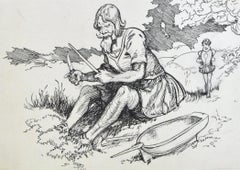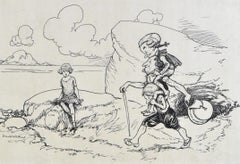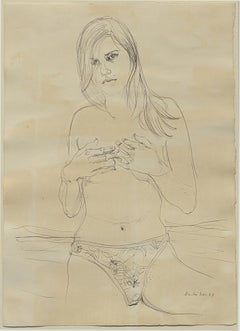Frank Watkins Drawings and Watercolor Paintings
to
3
3
3
Overall Height
to
Overall Width
to
3
3
2
2
1
1
1
1
3
3
3
806
412
269
228
3
Artist: Frank Watkins
Jack Escapes the Giant - 1920s British Children's illustration by Frank Watkins
By Frank Watkins
Located in London, GB
FRANK WATKINS
(1863-1929)
Jack Escapes the Giant
Pen and ink, unframed, in conservation mount only
24 by 29 cm., 9 ¾ by 11 ½ in.
(mount size 40 by 44.5 cm., 15 ¾ by 17 ½ in.)
Frank Henry Watkins was born in Lambeth, London and was the son of a bank clerk. He worked as a children’s book and comic illustrator in the early 20th century, drawing for many children’s stories including Dolly Twoshoes (1901); The Wonder and Dolly Daydream (1902); Illustrated Chips and Dick and Daisy (1919-1921) and also for Merry Moments. He provided book illustrations for The Man From the Moon by Philip Carmichael (1909); The Sun’s Babies by Edith Howes (1910); The King Who Never Died: Tales of King Arthur by Dorothy Senior (1910) and Fairy Rings...
Category
1920s Realist Frank Watkins Drawings and Watercolor Paintings
Materials
Ink
Original 1920s British Pen and ink Children's book Illustration by Frank Watkins
By Frank Watkins
Located in London, GB
FRANK WATKINS
(1863-1929)
The Boat Builder Giant
Pen and ink, unframed, in conservation mount only
20.5 by 29.5 cm., 8 by 11 ¾ in.
(frame size 36.5 by 45 cm., 14 ½ by 17 ¾ in.)
Frank Henry Watkins was born in Lambeth, London and was the son of a bank clerk. He worked as a children’s book and comic illustrator in the early 20th century, drawing for many children’s stories including Dolly Twoshoes (1901); The Wonder and Dolly Daydream (1902); Illustrated Chips and Dick and Daisy (1919-1921) and also for Merry Moments. He provided book illustrations for The Man From the Moon by Philip Carmichael (1909); The Sun’s Babies by Edith Howes (1910); The King Who Never Died: Tales of King Arthur by Dorothy Senior (1910) and Fairy Rings...
Category
1920s Realist Frank Watkins Drawings and Watercolor Paintings
Materials
Ink
The Travellers - 1920s British Children's book illustration by Frank Watkins
By Frank Watkins
Located in London, GB
FRANK WATKINS (1863-1929)
The Travellers
Signed
Pen and ink, unframed, in conservation mount only
17.5 by 26 cm., 7 by 10 ¼ in.
(frame size 33.5 by 41 cm., 13 ¼ by 16 in.)
Frank Henry Watkins was born in Lambeth, London and was the son of a bank clerk. He worked as a children’s book and comic illustrator in the early 20th century, drawing for many children’s stories including Dolly Twoshoes (1901); The Wonder and Dolly Daydream (1902); Illustrated Chips and Dick and Daisy (1919-1921) and also for Merry Moments. He provided book illustrations for The Man From the Moon by Philip Carmichael (1909); The Sun’s Babies by Edith Howes (1910); The King Who Never Died: Tales of King Arthur by Dorothy Senior (1910) and Fairy Rings...
Category
1920s Realist Frank Watkins Drawings and Watercolor Paintings
Materials
Ink
Related Items
"This should help you with the difficult Mr. Buckley" handwritten, signed letter
By Norman Rockwell
Located in New York, NY
Norman Rockwell
"This should help you with the difficult Mr. Buckley", ca 1965
Hand written and hand signed letter on artist's personalized stationery with the accompanying stamped and postmarked envelope.
Frame Included
Unique. Vintage handwritten...
Category
Mid-20th Century Realist Frank Watkins Drawings and Watercolor Paintings
Materials
Ink, Newsprint, Lithograph, Offset, Mixed Media
H 13.5 in W 12.5 in D 0.5 in
untitled / ohne Titel
By Martin Eder
Located in New York, NY
Martin Eder untitled work on paper executed in ballpoint pen with traces of watercolor. Ohne Titel Arbeit auf Papier, ausgeführt in Kugelschreiber mit Spuren von Aquarell. 2007
Category
Early 2000s Realist Frank Watkins Drawings and Watercolor Paintings
Materials
Ink, Watercolor, Pen
"Red Medusa Mantle" (Ruffled Kimono) - Hand Augmented Collotype
By Patricia A. Pearce
Located in Soquel, CA
Hand-augmented collotype on layered paper by Patricia A. Pearce (American, b. 1948). Signed "Patricia A. Pearce" in the lower right corner. Titled "Red Medusa...
Category
1980s Realist Frank Watkins Drawings and Watercolor Paintings
Materials
Paper, Ink, Pen, Color Pencil
H 30 in W 22.25 in D 0.03 in
Wroclaw - Contemporary Watercolor & Ink Landscape Painting, Architecture
By Mariusz Szałajdewicz
Located in Warsaw, PL
Mariusz Szalajdewicz (b. 1974)
Studied at the Faculty of Architecture at Warsaw University of Technology, where he mastered the drawing skill. Architect and urbanist, illustrator.
...
Category
21st Century and Contemporary Realist Frank Watkins Drawings and Watercolor Paintings
Materials
Ink, Watercolor, Paper
'The Enduring Attractions of the Open Market', Capitalism Satire
By Antonio Manganaro
Located in Santa Cruz, CA
Signed lower right, 'A. Manganaro' for 'Antonio Manganaro (Italian, 20th Century), and titled lower center, 'The Enduring Attractions of the Open Market'.
Matted Dimensions: 16 x 20
Category
Mid-20th Century Realist Frank Watkins Drawings and Watercolor Paintings
Materials
Gouache, Pen, Graphite, Paper, Ink
Louis Tinayre (1861-1942) An encampment of journalists, signed drawing
Located in Paris, FR
Louis Tinayre (1861-1942)
An encampment of journalists in Chambéry,
signed and titled lower left "Campement de journalistes à Chambéry"
Ink on paper
In quite good condition, a a visible vertical fold in the centre, some stains and foxings
21 x 29 cm
Framed : 33.7 x 45.5 cm
Louis Tinayre's background and adventurous life obviously shed light on this humorous and detailed scene. He shows a remarkable sense of observation, capturing as a journalistic illustrator this scene of extraordianarian life.
We don't know for the moment why these journalists had to improvise a camp, probably in a hotel room. No doubt it was to cover a trial or a sensational news item that had filled all the hotels in the city with journalists who had flocked for the occasion. In any case, what interests Tinayre as an almost ethnographic observer is this camp of journalists, of which he makes a tender and comical scene.
One understands him better when one knows how he could be fascinated in the same way by the territories of Madagascar, the North Pole or the Far West that he painted and drew.
Louis Tinayre was born on 14 March 1861 in Neuilly-sur-Seine. His mother, Victoire Tinayre, was a teacher and a member of the International Workers' Association.
Louis was the son of a Communard couple. His father, Jean Joseph, known as Jules Tinayre (Issoire 1821 - Paris 1871) was shot during the Bloody Week. His mother, Victoire Tinayre, fled with her children. Louis was the first to be sent to Hungary, and the rest of the family (including his brother Julien) joined him there later. He studied Fine Arts at the Hungarian University of Fine Arts in Budapest.
Returning to Paris in 1880 (after the amnesty), Louis Tinayre assiduously frequented Le Chat noir, where he met the positivists and Adèle Jacomet (Buenos Aires 1867-1946), whom he married in 1888.
He became an animal painter and press illustrator and was sent by Le Monde Illustré to cover the second expedition to Madagascar (then under French protectorate) in 1895.
He stayed there, fascinated, for six months and produced numerous drawings and photographs. Back in France, he created eight 5 x 4 meters dioramas presented at the National and Colonial Exhibition in Rouen in 1896.
He returned to Madagascar in 1898 to prepare the creation of a giant panorama representing the surrender of Antananarivo in 1895. The Malagasy pavilion at the 1900 Universal Exhibition in Paris allowed him to admire the dioramas (on the ground floor) and the panorama (on the first floor).
On his second trip, Tinayre took a Lumière cinematograph with him to document the daily life of the Malagasy people, no doubt to facilitate the design of the vast panorama. These short films were donated to the Cinémathèque française in 2009 by his grandson, Alain Tinayre.
One of the admirers of Tinayre's drawings, watercolours, paintings and photographs at the Universal Exhibition was Prince Albert I of Monaco: from 1901 onwards, Tinayre accompanied him on his hunts, painting scenes in North Africa, Russia, the Far West (Wyoming) and the North Pole. Tinayre, the official painter of the Prince's scientific expeditions, left his name to a glacier.
Together with the painter Alexandre Jean-Baptiste Brun, he painted the four murals in the large amphitheatre of the Oceanographic Institute in Paris. Louis Tinayre painted the figures while Alexandre Brun...
Category
1890s Realist Frank Watkins Drawings and Watercolor Paintings
Materials
Ink
"Boating on the Morin River"
By André Dunoyer de Segonzac
Located in Saint Amans des cots, FR
Pen, ink, watercolor and wash on paper by André Dunoyer de Segonzac, France, 1922-1924. Boating on the Morin River. Measurements : with frame: 52.5x65x2 cm - 20.7x25.6x0.8 inches / without frame: 36.5x45 cm - 14.4x17.7 inches. Signed lower left "A. Dunoyer de Segonzac". Colors may vary slightly depending on your screen. The lighter band at the top and the bottom of the piece, visible in the first picture, is only due to the reflection in the protective glass. It does not exist. In its frame gilt with gold leaf and its protective glass.
André Dunoyer de Segonzac was born in Boussy-Saint-Antoine (Essonne) July 7, 1884. After his schooling at high school Henri IV, as early as 1900, he attends classes at the National School of Fine Arts in Paris in free listener where he will befriend Charles Dufresne. In 1903, he enters the private studio of Luc-Olivier Merson. In 1907, he studies with Jean-Paul Laurens and attends the La Palette and Colarossi academies in Montparnasse. He meets Luc-Albert Moreau and Jean-Louis Boussingault with whom he shares a studio. His first drawings are published in 1908 in The Great Review and The Witness. Nearly indifferent to contemporary aesthetic revolutions, Dunoyer de Segonzac undertakes, with Jean-Louis Boussingault and Luc-Albert Moreau, to revive Gustave Courbet's realism by performing still lifes, nudes, landscapes, in a thick paste and masonry . In one of his letters to the painter Maurice Boitel, he wrote in the 1950s: "I have not forgotten the heroic period of the independents - when we were grouped around Paul Signac, the charming and valiant Maximilien Luce - in these barracks where the living and authentic Art was grouped outside the academic formulas - or literary and systematic tendencies - which were to lead to this abstract aesthetic of which the painting dies. "
In 1908, he begins exhibiting at the Salon d'Automne and the Salon des Indépendants, with Paul Signac and Maximilien Luce. He befriends Apollinaire, Max Jacob, Raoul Dufy and Vlaminck. From this period, renting a house belonging to Signac, Dunoyer discovers the landscapes of Saint-Tropez, to which he will remain faithful and where he lived until the end of his life. He stays in Saint-Tropez only in the summer season. For the rest, he leads a real nomadic life, in search of the motive especially through the Île-de-France, the Grand Morin valley, Feucherolles, Chennevières-sur-Marne, Guyancourt, etc. "I also worked a lot on the banks of the Seine in Chatou, Bougival, Andrésy, Poissy and Triel that I particularly like, with its beautiful Gothic church that is reflected in the Seine and the high wooded hills that surround him", he will say.
In 1910, he knows fashion designer Paul Poiret and meets Max Jacob, Raoul Dufy and Vlaminck. From 1910 to 1914, he travels to Italy, Spain, North Africa, and is interested in sport and dance (drawings of Isadora Duncan's Russian Ballets, 1911, The Boxers1910). From 1914 to 1918, mobilized in the infantry, he makes the war hardly, before being assigned to camouflage. He performs many war drawings, valuable for their artistic and documentary value.
From 1919, he appears again in many exhibitions, including major Parisian salons. Nearly indifferent to contemporary aesthetic revolutions, Dunoyer de Segonzac undertakes, with Boussingault and Moreau, to revive Courbet's realism by performing still lifes, nudes, landscapes, in a thick and masonry paste. Enlisted in engraving by Jean Émile Laboureur, he makes nearly 1,600 brass plaques from 1919 to 1970. He was president of the Society of French painters-engravers.
In 1921, he meets Paul Valéry, Léon-Paul Fargue and Jean Cocteau. In 1928, he makes a trip to America where he met with great success. In 1930, he becomes friend with Derain. In 1933 he receiveds the Carnegie Foundation of Pittsburgh Award and in 1934 the Venice Biennale.
During the Occupation, in November 1941, he takes part in a "study trip" to Germany, organized by Arno Breker, accepting, like other artists of the most renowned, to visit the hotspots of German culture as well as artist workshops.
After the war, he is exhibited in the best galleries...
Category
1920s Realist Frank Watkins Drawings and Watercolor Paintings
Materials
Paper, Ink, Watercolor, Pen
Pastoral Drawing of a Young Man Resting by the Roadside
Located in Philadelphia, PA
Jacques-Laurent Agasse
(Swiss, 1767-1849)
Young Man Resting by the Roadside, 1819
Pen and ink and wash on paper, 5 1/4 x 6 1/2 inches
Framed: 13 x 11 3/4 inches (approx.)
Signed and ...
Category
1810s Realist Frank Watkins Drawings and Watercolor Paintings
Materials
Paper, Ink, Pen
Gustave Fraipont (1849-1923) A peasant girl with her flock of Turkeys, drawing
By Gustave Fraipont
Located in Paris, FR
Gustave Fraipont (1849-1923)
A Peasant girl with her flock of Turkeys,
Ink and heightenings of blue watercolor on paper
23 x 15 cm
Signed on the lower left and titled on lower righ...
Category
1890s Realist Frank Watkins Drawings and Watercolor Paintings
Materials
India Ink, Watercolor
"Great Pine", Tree Inhabited by Human in Nature, Drawing and Pigments on Paper
By Frank Girard
Located in Clermont-Ferrand, Auvergne-Rhône-Alpes
This drawing by Frank Girard is created with pigments, Chinese ink, watercolors, acrylic, and colored pencils on 300g/m2 neutral white paper. It is not fr...
Category
2010s Realist Frank Watkins Drawings and Watercolor Paintings
Materials
Paper, Color Pencil, Acrylic, Ink, Watercolor, Pigment
H 25.6 in W 19.69 in D 0.02 in
'The Working Class Enjoying a Meal', Satire of Capitalism, Proletarian
By Antonio Manganaro
Located in Santa Cruz, CA
Signed lower left, 'A. Manganaro' for 'Antonio Manganaro (Italian, 20th Century), and titled lower center, 'Ability of the Working Classes to Enjoy Meals Under Humble Surroundings'. ...
Category
Mid-20th Century Realist Frank Watkins Drawings and Watercolor Paintings
Materials
Paper, Ink, Gouache, Pen, Graphite
(After) "The Gleaners" Ink Drawing Painting Study
Located in Houston, TX
The original "The Gleaners" is an oil painting by Jean-François Millet completed in 1857. It depicts three peasant women gleaning a field of stray stalks of wheat after the harvest. ...
Category
19th Century Realist Frank Watkins Drawings and Watercolor Paintings
Materials
Ink
H 14 in W 16 in D 0.001 in
Frank Watkins drawings and watercolor paintings for sale on 1stDibs.
Find a wide variety of authentic Frank Watkins drawings and watercolor paintings available for sale on 1stDibs. You can also browse by medium to find art by Frank Watkins in ink and more. Not every interior allows for large Frank Watkins drawings and watercolor paintings, so small editions measuring 11 inches across are available. Customers who are interested in this artist might also find the work of John Gould, Mariusz Szałajdewicz, and James March Phillips. Frank Watkins drawings and watercolor paintings prices can differ depending upon medium, time period and other attributes. On 1stDibs, the price for these items starts at $191 and tops out at $310, while the average work can sell for $223.




